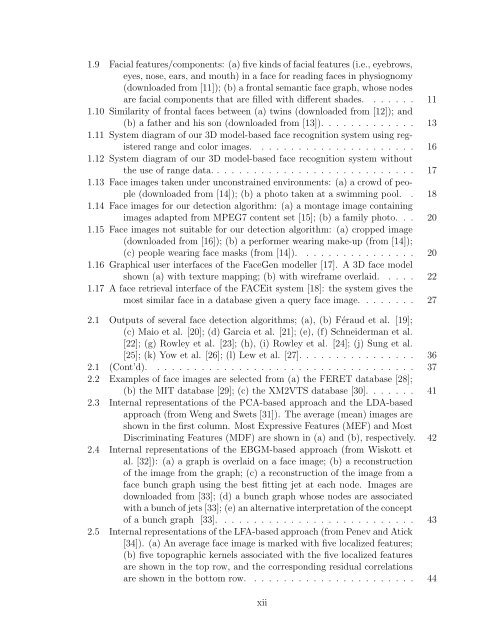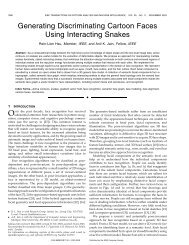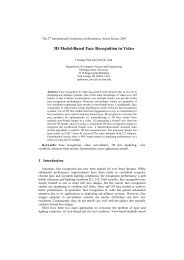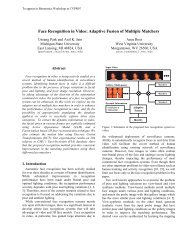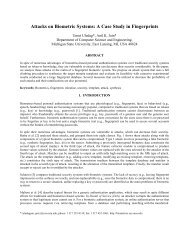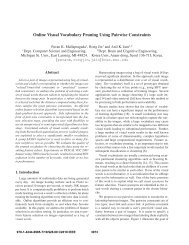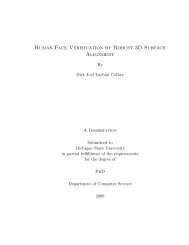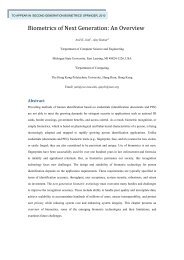Face Detection and Modeling for Recognition - Biometrics Research ...
Face Detection and Modeling for Recognition - Biometrics Research ...
Face Detection and Modeling for Recognition - Biometrics Research ...
You also want an ePaper? Increase the reach of your titles
YUMPU automatically turns print PDFs into web optimized ePapers that Google loves.
1.9 Facial features/components: (a) five kinds of facial features (i.e., eyebrows,<br />
eyes, nose, ears, <strong>and</strong> mouth) in a face <strong>for</strong> reading faces in physiognomy<br />
(downloaded from [11]); (b) a frontal semantic face graph, whose nodes<br />
are facial components that are filled with different shades. . . . . . . 11<br />
1.10 Similarity of frontal faces between (a) twins (downloaded from [12]); <strong>and</strong><br />
(b) a father <strong>and</strong> his son (downloaded from [13]). . . . . . . . . . . . . 13<br />
1.11 System diagram of our 3D model-based face recognition system using registered<br />
range <strong>and</strong> color images. . . . . . . . . . . . . . . . . . . . . . 16<br />
1.12 System diagram of our 3D model-based face recognition system without<br />
the use of range data. . . . . . . . . . . . . . . . . . . . . . . . . . . . 17<br />
1.13 <strong>Face</strong> images taken under unconstrained environments: (a) a crowd of people<br />
(downloaded from [14]); (b) a photo taken at a swimming pool. . 18<br />
1.14 <strong>Face</strong> images <strong>for</strong> our detection algorithm: (a) a montage image containing<br />
images adapted from MPEG7 content set [15]; (b) a family photo. . . 20<br />
1.15 <strong>Face</strong> images not suitable <strong>for</strong> our detection algorithm: (a) cropped image<br />
(downloaded from [16]); (b) a per<strong>for</strong>mer wearing make-up (from [14]);<br />
(c) people wearing face masks (from [14]). . . . . . . . . . . . . . . . 20<br />
1.16 Graphical user interfaces of the <strong>Face</strong>Gen modeller [17]. A 3D face model<br />
shown (a) with texture mapping; (b) with wireframe overlaid. . . . . 22<br />
1.17 A face retrieval interface of the FACEit system [18]: the system gives the<br />
most similar face in a database given a query face image. . . . . . . . 27<br />
2.1 Outputs of several face detection algorithms; (a), (b) Féraud et al. [19];<br />
(c) Maio et al. [20]; (d) Garcia et al. [21]; (e), (f) Schneiderman et al.<br />
[22]; (g) Rowley et al. [23]; (h), (i) Rowley et al. [24]; (j) Sung et al.<br />
[25]; (k) Yow et al. [26]; (l) Lew et al. [27]. . . . . . . . . . . . . . . . 36<br />
2.1 (Cont’d). . . . . . . . . . . . . . . . . . . . . . . . . . . . . . . . . . . . 37<br />
2.2 Examples of face images are selected from (a) the FERET database [28];<br />
(b) the MIT database [29]; (c) the XM2VTS database [30]. . . . . . . 41<br />
2.3 Internal representations of the PCA-based approach <strong>and</strong> the LDA-based<br />
approach (from Weng <strong>and</strong> Swets [31]). The average (mean) images are<br />
shown in the first column. Most Expressive Features (MEF) <strong>and</strong> Most<br />
Discriminating Features (MDF) are shown in (a) <strong>and</strong> (b), respectively. 42<br />
2.4 Internal representations of the EBGM-based approach (from Wiskott et<br />
al. [32]): (a) a graph is overlaid on a face image; (b) a reconstruction<br />
of the image from the graph; (c) a reconstruction of the image from a<br />
face bunch graph using the best fitting jet at each node. Images are<br />
downloaded from [33]; (d) a bunch graph whose nodes are associated<br />
with a bunch of jets [33]; (e) an alternative interpretation of the concept<br />
of a bunch graph [33]. . . . . . . . . . . . . . . . . . . . . . . . . . . 43<br />
2.5 Internal representations of the LFA-based approach (from Penev <strong>and</strong> Atick<br />
[34]). (a) An average face image is marked with five localized features;<br />
(b) five topographic kernels associated with the five localized features<br />
are shown in the top row, <strong>and</strong> the corresponding residual correlations<br />
are shown in the bottom row. . . . . . . . . . . . . . . . . . . . . . . 44<br />
xii


